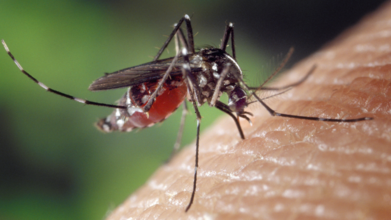- Health Conditions A-Z
- Health & Wellness
- Nutrition
- Fitness
- Health News
- Ayurveda
- Videos
- Medicine A-Z
- Parenting
- Web Stories
Heather Dubrow Warns Of ‘Ozempic Vulva’; What Is This Unique Symptom of Taking Ozempic?

Credits: Canva
Dr. Terry Dubrow and his wife, Heather Dubrow, recently spoke about a lesser-known side effect of the popular weight-loss drug Ozempic. The reality TV couple revealed on their iHeart podcast ‘Between Us’ that even their four kids were shocked by the conversation.
Ozempic has been gaining attention as a weight-loss medicine, but many users are not aware of certain effects it may have. However, Heather and Terry highlighted one unique change that has started making waves online, the “Ozempic vulva.”
Also Read: Listeria Outbreak That Recalled Frozen Foods From Walmart Leaves 4 Dead, And 19 In Hospital
Heather Dubrow Warns of ‘Ozempic Vulva’: What You Need to Know
During the podcast, the couple didn’t hold back. Terry admitted, “We talked about stuff that’s shockingly personal, maybe even a little TMI.” Heather chimed in, noting, “Our kids definitely were not thrilled when we started discussing Ozempic vulva.” Terry, with his medical expertise, explained the reasoning behind it, saying, “Rapid fat loss can reduce estrogen levels, which may lead to less lubrication, irritation, and changes in volume in that area.”
What Is Ozempic Vulva?
“Ozempic vulva” is not a medical term but a trendy phrase describing how some women notice changes in their vulva after taking Ozempic or similar weight-loss medications. These changes are usually linked to rapid weight loss rather than the drug itself. Most commonly, women report that the outer lips of the vulva look less full or appear saggy, and they may experience dryness, irritation, or discomfort.
How Ozempic Works?
Ozempic contains semaglutide, a prescription drug mainly used to manage type 2 diabetes by lowering blood sugar. It mimics a natural hormone called GLP-1, which helps the body release insulin when blood sugar is high, slows digestion, and reduces appetite. Beyond diabetes management, Ozempic has become popular for weight loss, especially among people with obesity or those at risk of heart disease.
Also Read: Why Is This Doctor Asking President Trump To Take Alzheimer's Test?
According to Prabha Sivaraman, a consultant obstetrician-gynecologist in the UK, as per Healthline, the phenomenon is not directly caused by Ozempic. “Women are seeing the effects of rapid weight loss on soft tissues. The drug doesn’t act on the vulva, vagina, or pelvic floor directly. These changes are simply by products of body composition shifting quickly,” she explains. Rapid fat loss can particularly affect areas like the mons pubis and labia majora, which normally provide volume and shape.
Ozempic Side Effects
While Ozempic vulva is not an official medical side effect, the drug can cause more common issues such as nausea, vomiting, diarrhea, constipation, stomach pain, reduced appetite, or fatigue. Rarely, serious complications like pancreatitis, kidney or gallbladder problems, or severe allergic reactions can occur. Anyone taking Ozempic should do so under medical supervision and report unusual or severe symptoms to their doctor.
Why Does Ozempic Vulva Happen?
Several factors linked to rapid weight loss may contribute:
- Loss of fat and volume: Labia majora contain fatty tissue, and losing fat quickly can make them look thinner or less full.
- Changes in muscle and tissue tone: Weight loss can reduce muscle mass, affecting pelvic support and possibly changing sensation.
- Dehydration and hormonal shifts: Side effects like nausea or diarrhea can cause fluid loss, while lower estrogen from fat loss may reduce natural lubrication.
- Shifts in vaginal microbiome: Rapid changes in diet, digestion, and body chemistry can affect the balance of healthy bacteria, potentially causing irritation, odor, or unusual discharge.
DISCLAIMER: Ozempic vulva is not a direct effect of the drug itself but reflects how rapid weight loss can change the appearance and comfort of the vulva. Staying hydrated and using lubricants can help, and for those concerned, medical advice or cosmetic options are available.
Trump Administration Quietly Approves Abortion Pill Mifepristone Amid RFK Jr.’s FDA Safety Review

Credits: Canva
The Trump administration has quietly approved a new generic version of the abortion pill mifepristone, a move announced by the Food and Drug Administration this week that has drawn sharp criticism from anti-abortion leaders.
The decision comes less than two weeks after Health and Human Services Secretary Robert F. Kennedy Jr. and FDA Commissioner Martin Makary confirmed a review of abortion pill safety, a review initially welcomed by anti-abortion activists. Now, those same leaders are questioning the administration’s commitment to their cause, marking one of the first notable pushbacks Trump has faced from his usually loyal socially conservative base.
Trump Administration Quietly Approves Generic Mifepristone, Sparking Backlash
Federal regulators have approved a new generic version of the abortion pill mifepristone, a routine regulatory step that immediately drew criticism from anti-abortion groups and politicians aligned with the Trump administration.
The approval was announced by Evita Solutions, the drugmaker, on its website. The company’s low-cost version of mifepristone is approved for ending pregnancies up to 10 weeks gestation. Students for Life Action, an anti-abortion organization, responded to the news calling the move “a stain on the Trump presidency” and describing it as further evidence that the “deep state at the FDA must go.”
The decision shows the ongoing tension between expanding access to abortion medication and opposition from socially conservative groups who remain critical of regulatory agencies’ role in approving such drugs.
What Is Mifepristone?
According to the FDA, mifepristone blocks the hormone progesterone, which is essential for a pregnancy to continue. Used in combination with misoprostol, it can safely end an intrauterine pregnancy up to ten weeks gestation (70 days or less since the first day of the last menstrual period).
The approved dosing schedule is:
- Day 1: 200 mg of mifepristone taken orally
- 24–48 hours later: 800 mcg of misoprostol taken buccally (in the cheek) at an appropriate location
- 7–14 days later: follow-up with a healthcare provider
Mifepristone: Who Will Make It?
The generic version will be produced by Evita Solutions LLC, a company that says its mission is to “normalize abortion” and make it “accessible to all.” The FDA confirmed the approval, stating that the submitted application contained sufficient data to meet federal standards.
Mifepristone: Safety and Controversy
Decades of peer-reviewed studies show that serious adverse reactions to mifepristone occur in fewer than 0.5 percent of patients, and the drug has been FDA-approved and widely used for over 20 years.
Despite this, earlier this year, a report by the Ethics and Public Policy Center, a right-wing think tank, questioned the safety of the pill, claiming serious complications were 22 times higher than previous estimates and urging the FDA to reconsider its approval.
This latest approval underscores the ongoing tensions in U.S. abortion politics, as the Trump administration’s decision to quietly greenlight generic mifepristone clashes with the expectations of socially conservative supporters.
Exposure To THIS Long-Banned Chemical May Raise Parkinson’s Chances, Reveals Study

Credits: Canva
Parkinson’s disease (PD) is a progressive condition of the nervous system that mainly affects movement. It often begins with mild symptoms such as tremors, stiffness, or slower movement, which worsen over time. Balance issues and coordination problems also appear as the disease progresses. While the exact cause remains unclear, both genetics and environmental factors are believed to play a role. As per Mayo Clinic, there is no cure yet, but treatments including medication, therapy, and surgery can help control symptoms.
Interestingly, now a new study has drawn attention to a possible environmental trigger which is exposure to a widely banned industrial chemical.
Study Links Chemical Exposure to Parkinson’s
Researchers have reported that long-term exposure to trichloroethylene (TCE), a chemical once common in metal degreasing and dry cleaning, may increase the risk of Parkinson’s. The study, published in Neurology, found that seniors living in areas with the highest airborne levels of TCE had a 10% higher risk of developing Parkinson’s compared to those in areas with lower levels.
The findings became more striking in Oregon, where people living one to five miles downwind of a factory that used TCE showed a fourfold increase in Parkinson’s risk. “Long-term exposure to trichloroethylene in outdoor air was associated with a small but measurable increase in Parkinson’s risk,” said lead researcher Brittany Krzyzanowski of the Barrow Neurological Institute in Phoenix. She added that the research adds to growing evidence linking environmental exposures to the disease.
What Is Trichloroethylene (TCE)?
Trichloroethylene which is also known as TCE is a synthetic, colorless liquid that was widely used in industries as a degreaser and chemical ingredient. It could also be found in some consumer products such as paint removers and stain cleaners. The chemical is classified as a known human carcinogen, linked to cancers of the kidney and liver, along with immune and reproductive damage. People may be exposed to it through inhalation, ingestion, or skin contact.
In the United States, despite restrictions on its use, TCE still spreads through soil, water, and air. Past studies have suggested a link between TCE and Parkinson’s, particularly among workers exposed in industrial settings. What makes this new study interesting is that it examined exposure on a population level across the entire country, not just workplaces.
What Is Parkinson’s?
Parkinson’s is a progressive neurological disorder that develops slowly. It often starts with subtle signs, like tremors in the hands, jaw, or feet, before moving on to stiffness, slowed movement (bradykinesia), and difficulties with balance or posture. Over time, facial expressions may fade, speech can become soft or slurred, and daily tasks such as dressing or walking grow harder.
Other symptoms include muscle rigidity, changes in handwriting, reduced automatic movements like blinking, and problems with memory, sleep, or mood. While the disease can’t be cured, medication and, in some cases, brain surgery can help manage symptoms.
Why This Study Matters
The research does have limitations. It focused mainly on older adults, so it doesn’t fully address risks for younger individuals or those with early-onset Parkinson’s. Air pollution data used in the study also came from a single time point, which may not capture lifetime exposure levels.
Still, the findings bring weight to the theory that Parkinson’s is shaped not only by genetics but also by the environment. Previous studies have already brought light to the pesticides such as paraquat and general air pollution as possible risk factors. This new evidence places banned industrial chemicals like TCE on that list, pointing to the urgent need to understand how environmental toxins may influence neurological health.
Two Species Of Disease-Carrying Mosquitoes Detected in UK Amid Rising Climate Risks

Credits: Canva
Amid the ongoing Covid-19 scare in the UK, in another news, two species of disease-carrying mosquito have been also found there. These two species are now being found as a result of climate change, scientists too have warned against the same.
Aedes aegypti, also known as the Egyptian mosquito, and Aedes albopictus, also known as the (Asian) tiger or forest mosquito, both known for carrying diseases like yellow fever, dengue, chikungunya, Zika and dirofilariasis have been detected in surveillance traps set by the UK Health Security Agency (UKHSA). This was revealed in the UKHSA peer-reviewd study on invasive mosquito surveillance.
The Egyptian mosquito eggs were detected in a freight storage facility near London's Heathrow Airport, in September 2023- and tiger mosquitoes were detcted in August 2024. This will be the first time that the tiger mosquitoes have been detected since 2019, at a motorway srvice station in Kent.
The study published in research journal PLOS Global Public Health, reported the findings were lead by UKHSA and the Centre for Climate and Health Security.
What Has Changed Now?
Historically, both these species were limited to subtropical and tropical regions, however, among the populations established in southerns and central Europe, the mosquitoes have shown its ability to survive in temperate climates.
Rising temperature is said to be one of the major reasons for incursion of invasive species. This has put new populations at risk of disease transmission.
The authors of the study said, "While there is currently no evidence that Ae. albopictus or Ae. aegypti are widely established in the UK, without timely action, the UK faces the risk of invasive mosquito populations becoming established... proactive measures enhance resilience against emerging vector borne disease risks."
Call To Action
In addition to monitoring at ports and transport hubs across England, Wales and Northern Ireland, the UKHSA has also set up traps in the Kent marshes—considered an ideal spot for mosquitoes to settle due to its warm, wet conditions.
The UKHSA has also run Mosquito Recoding Scheme (MRS). This is a citizen-science project that receives and identifies mosquitoes submitted by members of public, including in response to nuisance biting incidents. Between 2005 and 2021, 286 reports of mosquitoes were submitted to the MRS, all of which were native UK species.
The aim of the scheme is to detect unusual or invasive species of mosquito, so prevention tactics could be put to use.
Collin Johnson, the lead author of the study and a senior medical entomologist at the UKHSA, said for the 2023 and 2024 discoveries: "Each detection triggered enhanced local surveillance and control measures, and the fact that no further specimens were found suggests these were isolated incursions."
"The collaborative efforts between UKHSA, local authorities and landowners were key to rapidly mobilising and preventing the establishment of invasive mosquitoes," he said.
© 2024 Bennett, Coleman & Company Limited

